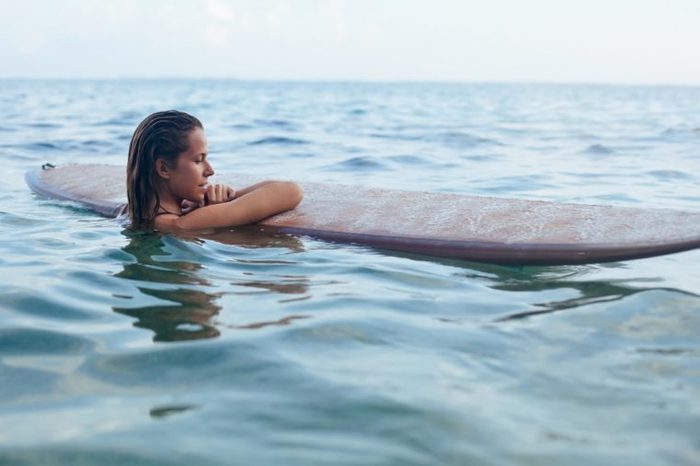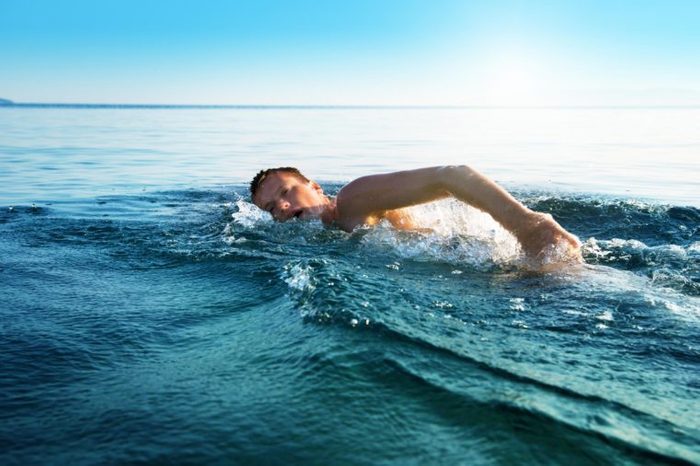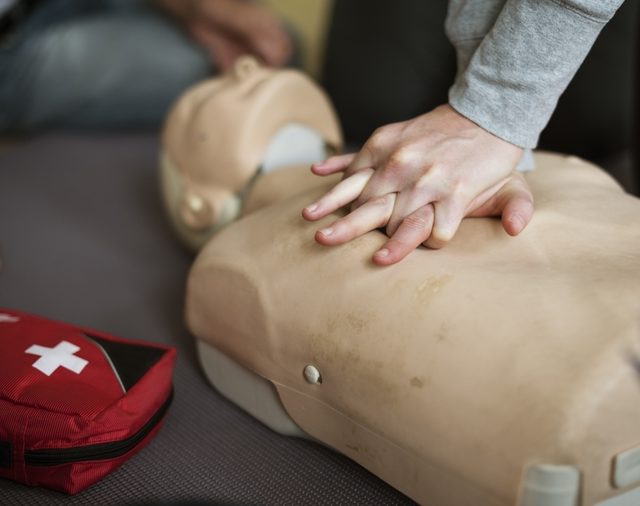
Never swim alone
Even Penny Oleksiak isn’t immune to this very important rule. “If a lone swimmer suffers any sort of injury while in the water or runs into a perilous situation, he or she may not be able to get help quickly and is at a much greater risk of drowning,” explains Caitlin Hoff, health and safety investigator for ConsumerSafety.org. To prevent an emergency situation, she recommends that swimmers always swim with a buddy ideally in an area with an on-duty lifeguard.
Read up on secrets lifeguards desperately want you to know.

Designate a “water watcher”
The most ideal “water watcher” is a certified lifeguard, but they’re not always available—or on call. Medical events or accidents can happen at any time, so at the very least, make sure another adult is present when you, or your children, swim. Chris McCuiston, CEO and founder of Goldfish Swim School recommends designating a “water watcher,” someone who will avoid cell phones, conversations, magazines, and anything else that might distract that adult from keeping an eye on swimmers at all times. “Even though there are many people around, sometimes no one is actually watching the swimmers (especially the younger swimmers!) in the pool,” he says. “Adults can take turns and trade off in this role, but it is one simple and easy tip that we can all use to keep everyone safer in the water.”
It took 70 strangers to rescue these two boys from a riptide.

Don’t overestimate your swimming abilities
This is especially important if you haven’t been in the water for several years or are swimming in a new environment. “Swimming in an ocean, lake or river can bring additional challenges such as cold temperatures, currents, and underwater hazards, so be sure that you have the skills for these environments,” says Nichole Steffens, Aquatics Product Manager for the American Red Cross. “Most adults are overconfident in their water skills and by the time they feel nervous about the conditions, they are likely already in trouble.”
Afraid to swim in the open water? Here are 13 reassuring facts about sharks.

It is never too late to learn to swim!
If you didn’t learn to swim as a child, there’s no time like the present. “We often hear from parents that swim lessons are a priority for their children because they never had the opportunity to learn to swim themselves,” explains McCuiston. “We encourage everyone to invest the time to learn how to swim to protect themselves (and their children) from drowning.”
Read up on the 50 best beaches in the world.

Don’t “drink and dive”
It might be fun and relaxing to enjoy a beach or poolside cocktail once in a while, but be very careful not to overdo it. “Alcohol impairs judgment, balance, and coordination, impacts a person’s ability to operate watercraft safely, affects swimming skills, and reduces the body’s ability to stay warm,” warns Steffens. If you’re going to be drinking while camping out near a body of water, be sure to sober up before taking a dip.

Never dive head first into an unknown body of water
If you’re not sure how deep a body of water is—or what may be lying underneath the surface—don’t ever jump into it. “Diving head first into a shallow or rocky area can result in serious spinal cord injuries,” says Hoff. “By taking the smallest precautions and walking into the water feet first, you can protect your body from serious physical damage.”

Wear a life jacket while boating
Many adults assume that life jackets are only for people or pets who don’t know how to swim, but this is far from the truth. “Even the strongest swimmers have been saved by life jackets when a boat has capsized or they get caught in a rip current,” explains Elizabeth Malson, Certified Emergency First Responder Instructor, PADI Master Scuba Diver Training, President of Amslee Institute and teacher of their Water Awareness Course.
Here are 10 everyday emergencies you need to know how to manage.

Swim in designated areas
If there’s a swimming section roped off at the lake or pool, use it. “Often, public swimming areas, natural and manmade, have designated swimming areas that are free of boat traffic and have been cleared of underwater hazards,” says Malorie Thompson, certified water safety instructor. “In addition, designated swim areas are usually free of swift currents and often have lifeguards present.” If you’re not sure which areas of a body of water are safe for a swim, ask around. “Local visitor centres often have information on the best places to safely swim, or who to contact for further information on swimming conditions.

Become CPR-trained
There are many reasons to become CPR certified, and number one is to protect yourself and your loved ones from drowning. Taking a class makes you more prepared. “The Red Cross offers water safety and CPR/AED training to help prepare adults to prevent and respond to emergencies,” says Steffens.

Limit sun exposure
We’ve all lost track of time and come home with a sunburn, but don’t forget that you’re more susceptible when you’re near a body of water. “The water can reflect additional rays onto your skin so it’s vital to wear sunscreen and reapply it every 60 to 90 minutes,” says Malson. Wearing hats, sunglasses, and rash guards can limit sun damage, as can staying out of the sun when rays are the strongest—between 10 a.m. and 3 p.m.

Respect the rules
“Rules are created from lessons learned, so don’t dive in shallow areas of the pool or jump off a river bank without knowing the depth and safety of the water below,” says Malson. “Mind flag warnings at the beach and stay out of the water if rip currents are present.” She also recommends wearing a helmet when jet skiing and following all coast guard rules for boating, kayaking, paddle boarding, and participating in other water sports.

Create an emergency plan and training
When going to a new water destination, Malson suggests taking a few minutes and talk through an emergency plan. Where will you meet up if you get separated? Are there landline phones or cell phone service to call for help if needed? Who is in charge of watching children? “No one wants to experience an emergency but being prepared can save lives,” she says. “Take an emergency first aid and CPR class so that you are prepared to help if needed.”
Next, learn about the most common travel illnesses (and how to avoid them).